10 Ways that Frogs and Toads Help Your Garden: Nature’s Little Gardeners at Work
Frogs and toads are amazing little creatures that can do wonders for your garden. These helpful amphibians eat lots of bugs that might harm your plants.
They also make your garden more diverse and healthy.
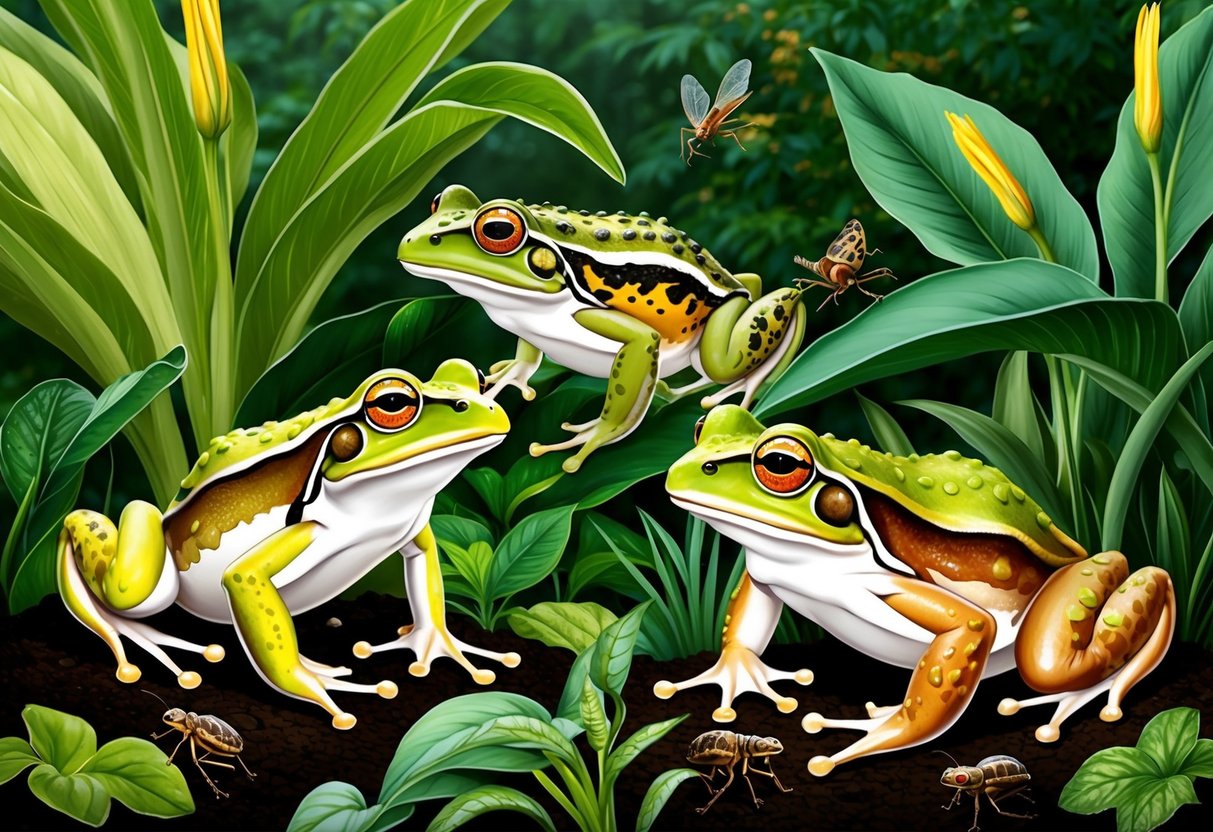
Frogs and toads can eat up to 100 insects in a single night, including mosquitoes, slugs, and harmful pests. This natural pest control helps keep your plants safe without using chemicals.
Plus, having frogs and toads around makes your garden more lively and fun.
Gardens with frogs and toads are often healthier. These creatures help spread nutrients in the soil and keep the ecosystem balanced.
They also serve as indicators of a clean environment. If you see frogs and toads, it usually means your garden is doing well.
Key Takeaways
- Frogs and toads provide natural pest control in gardens
- These amphibians contribute to a healthier garden ecosystem
- Having frogs and toads indicates a clean and balanced garden environment
Pest Control Allies
Frogs and toads are great helpers in keeping gardens healthy. They eat many bugs that can damage plants.
These amphibians also stop some plant diseases from spreading.
Natural Insect Reduction
Frogs and toads are hungry insect-eaters. They munch on caterpillars, beetles, moths, and slugs.
This helps keep bug numbers down without using chemicals.
A single frog can eat lots of insects each day. This means fewer pests attacking garden plants.
Frogs work day and night to catch bugs.
Different frog types like different insects. This gives gardens wide pest protection. American Toads enjoy moist, shady spots and eat many common garden pests.
Disease Prevention in Gardens
By eating insects, frogs and toads help stop plant diseases too. Many bugs spread plant sicknesses as they move around.
Fewer bugs means less chance for diseases to spread.
Some frogs eat mosquitoes, which can carry plant viruses. This helps keep plants healthier.
Toads eat snails and slugs that often spread fungal diseases to plants.
Frogs and toads also keep the bug population balanced. This balance helps stop any one pest type from taking over.
A diverse garden with many bug types is often healthier than one with just a few pest species.
Biodiversity Boosters
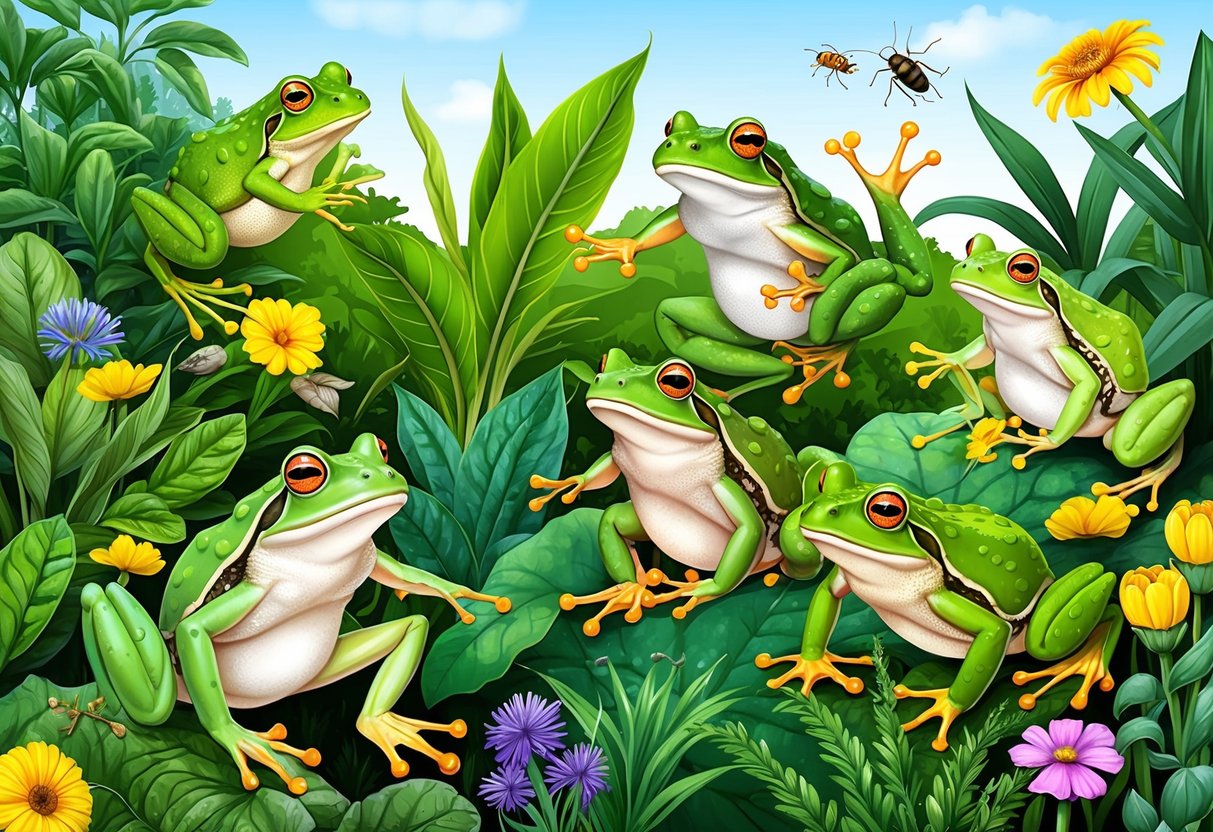
Frogs and toads play a key role in making gardens more diverse. They help create a rich ecosystem by attracting other animals and supporting local wildlife.
Pollinator Attraction
Frogs and toads indirectly help pollination in gardens. They eat insects that might harm pollinators like bees and butterflies.
This protection allows more pollinators to visit flowers.
Native plants that frogs like also tend to attract pollinators. These plants often have nectar-rich flowers that bees and butterflies love.
A garden with frogs is likely to have more insects. This increased insect activity can lead to better pollination of fruits and vegetables.
Supporting Local Wildlife
Frogs and toads are an important food source for many animals. Birds, snakes, and small mammals often eat these amphibians.
By having frogs in the garden, you’re providing food for other wildlife.
Adding water features like ponds or birdbaths can help frogs and attract more animals. These water sources become gathering spots for various creatures.
Frogs also eat pests that might harm other wildlife. This helps keep the garden ecosystem in balance.
A diverse garden with frogs is more likely to have a healthy mix of different animal species.
Soil Health and Fertility
Frogs and toads play a key role in keeping garden soil healthy. They improve soil structure and help recycle nutrients through their activities.
Aeration Through Movement
Frogs and toads hop and burrow in the soil, creating small holes and tunnels. This natural digging action helps aerate the soil, allowing more oxygen to reach plant roots.
Better aeration leads to healthier root growth and improved nutrient uptake.
Their movement also breaks up compacted soil. This makes it easier for water to penetrate and reduces runoff.
Looser soil structure helps beneficial microorganisms thrive.
As frogs and toads move about, they mix organic matter into the soil. This improves soil texture and water retention.
The result is a richer growing environment for plants.
Nutrient Recycling
Frogs and toads contribute to nutrient recycling in the garden. As they eat insects and other small creatures, they process those nutrients through their bodies.
Their waste then adds organic matter back to the soil.
This amphibian poop is rich in nitrogen and other elements plants need. It acts as a natural fertilizer, feeding the soil food web.
Microorganisms break down the waste, releasing nutrients in a form plants can use.
Frog and toad droppings also contain undigested insect parts. These break down over time, further enriching the soil.
This ongoing process helps maintain soil fertility without the need for chemical fertilizers.
Plant Growth Promoters
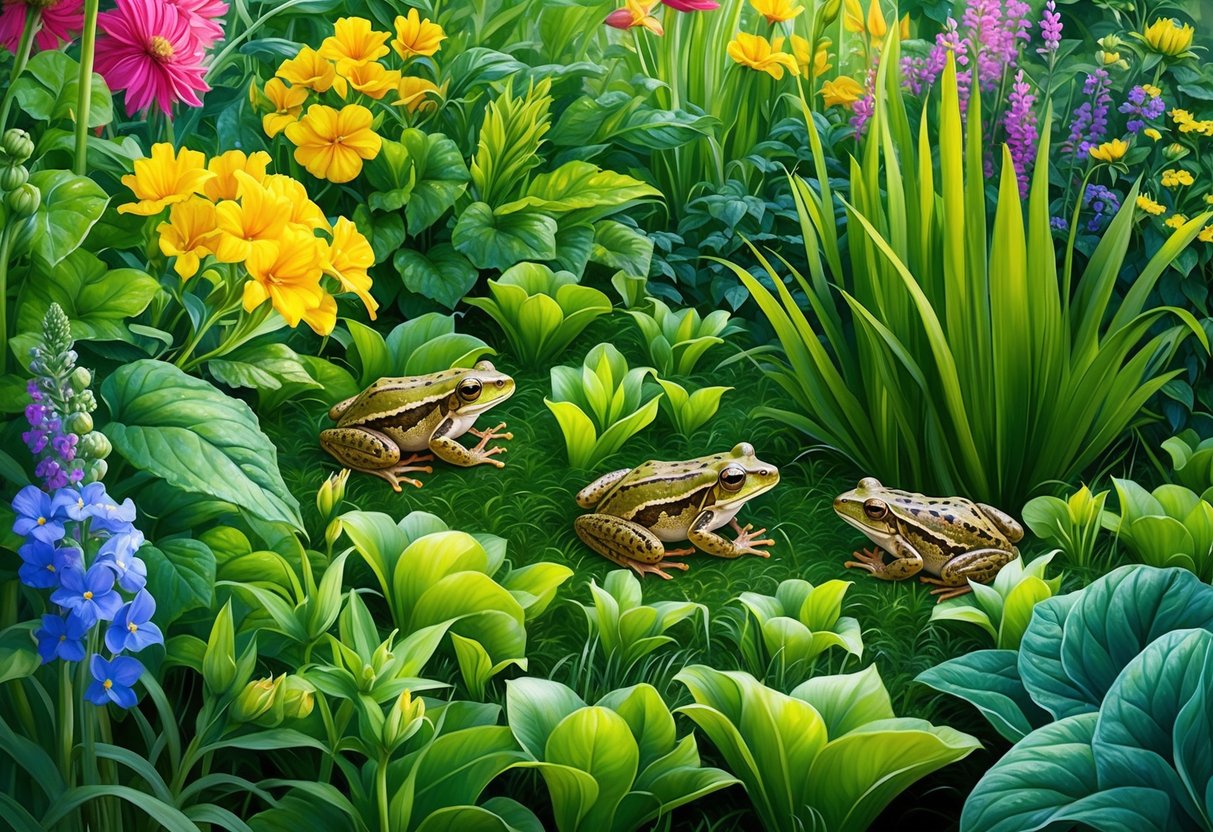
Frogs and toads play a key role in promoting healthy plant growth in gardens. They help regulate harmful organisms and contribute to a balanced ecosystem.
Fungus and Weed Regulation
Frogs and toads are natural pest controllers in gardens. They eat many insects that can damage plants, including those that spread fungal diseases.
This helps keep plants healthier and reduces the need for chemical treatments.
These amphibians also eat slugs and snails. These creatures often munch on young seedlings and tender leaves.
By controlling slug and snail populations, frogs and toads protect vulnerable plants.
Some frogs and toads even eat weed seeds. This can help slow the spread of unwanted plants in the garden.
With fewer weeds, garden plants face less competition for water and nutrients.
Frogs and toads produce waste that acts as a natural fertilizer. Their droppings add nutrients to the soil, helping plants grow stronger.
This organic boost can lead to lusher, more vibrant gardens.
Water Quality Protectors
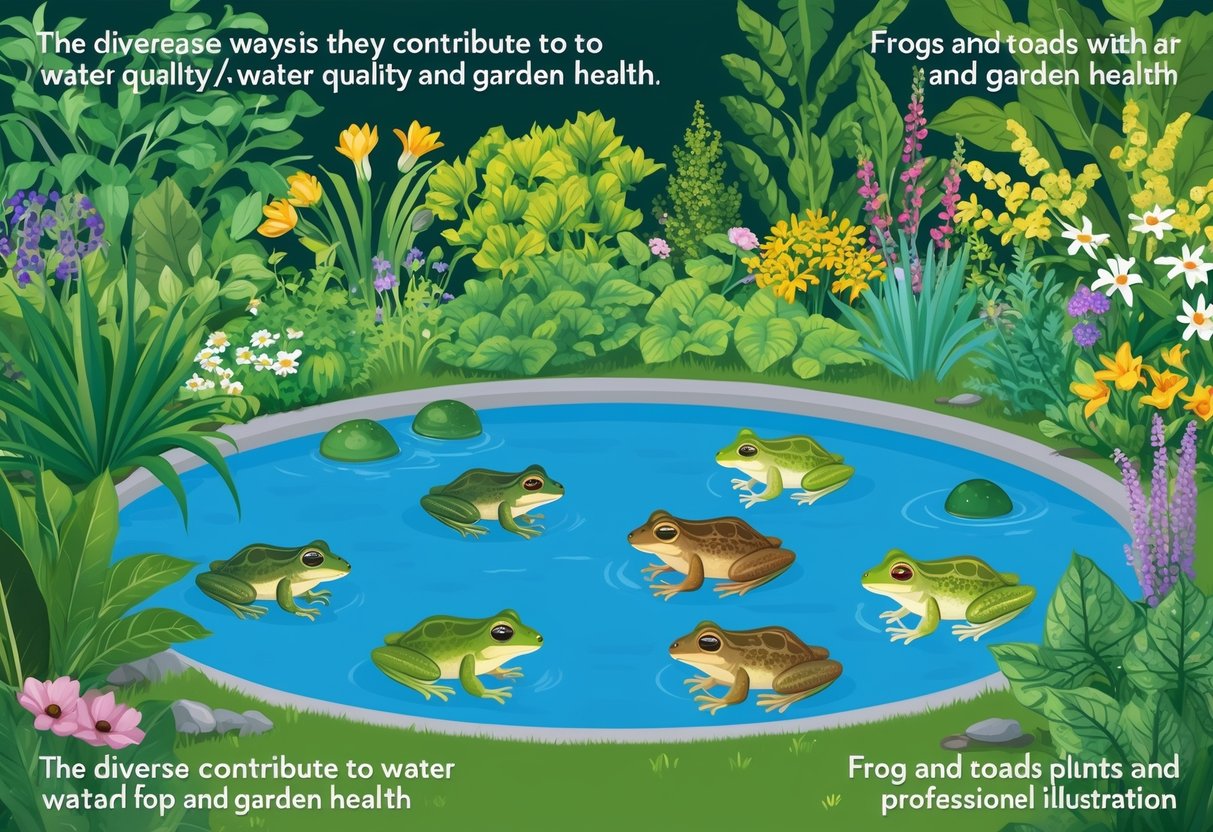
Frogs and toads play a key role in keeping garden ponds and water features clean and balanced. These amphibians act as natural filters, helping maintain healthy aquatic ecosystems.
Algae Balancing
Frogs and toads are great at keeping algae in check. They eat insects that would otherwise decompose in the water and feed algae growth.
This helps prevent algae from taking over ponds and water features.
These amphibians also eat algae directly, further reducing its spread. Their tadpoles are particularly helpful, as they feed on algae as their main food source.
By controlling algae, frogs and toads help keep water clear and oxygenated.
This creates a better environment for other plants and animals in the garden pond.
Gardeners can encourage these helpful creatures by adding a small pond or water feature. Even a simple ground-level birdbath can attract moisture-loving amphibians to the garden.
Garden Education and Awareness
Frogs and toads in the garden offer great chances to learn about nature. Kids and adults can see how these animals live and grow right in their own backyard.
Natural Lifecycle Observation
Watching frogs and toads in the garden can teach a lot about animal life cycles. People can see how they change from eggs to tadpoles to adults.
This gives a real-life look at metamorphosis.
Kids might spot frog eggs in a garden pond or birdbath. They can check back often to see the tadpoles hatch and grow legs.
Gardeners can learn when different frog species are active. Some come out at night, while others are busy during the day.
This hands-on learning can spark interest in nature and science. It may inspire people to protect local wildlife and their habitats.
Economical Benefits
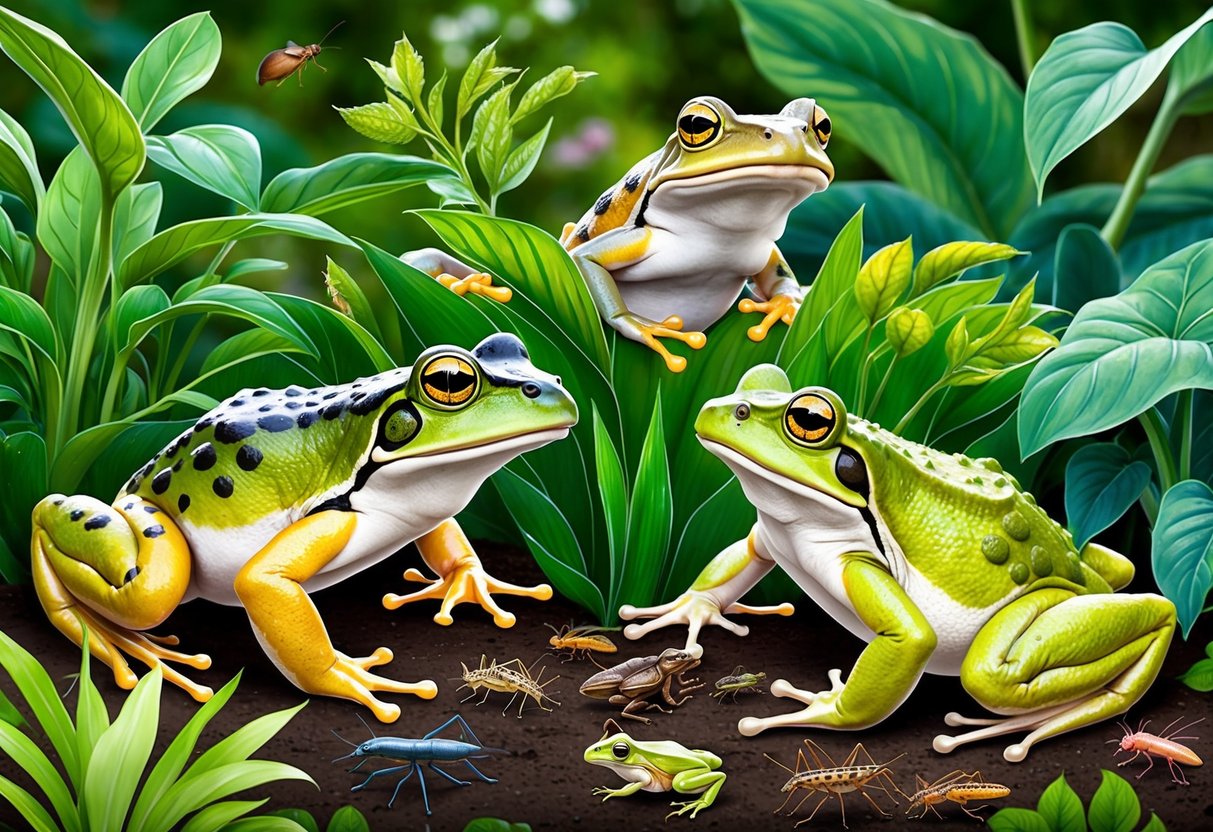
Frogs and toads offer cost-saving advantages for gardeners. They provide free pest control services, reducing the need for expensive chemicals and manual labor.
Reduced Need for Chemicals
Frogs and toads are natural pest controllers in gardens. They eat a wide variety of insects, including mosquitoes, flies, moths, and beetles. This helps keep pest populations in check without using costly pesticides.
By having frogs and toads around, gardeners can save money on chemical treatments. These amphibians work for free, 24/7, keeping the garden ecosystem balanced.
Fewer chemicals also mean healthier soil and plants. This can lead to better crop yields and less money spent on fertilizers and soil treatments.
Attracting frogs and toads is simple and inexpensive.
Adding a small water feature like a terra-cotta saucer filled with water can entice them to stay. Providing shelter with native plants or simple structures costs little but offers big returns.
The economic benefits extend beyond the garden too. By supporting local frog and toad populations, gardeners contribute to the wider ecosystem’s health, potentially reducing community pest control costs.
Aesthetic and Emotional Value
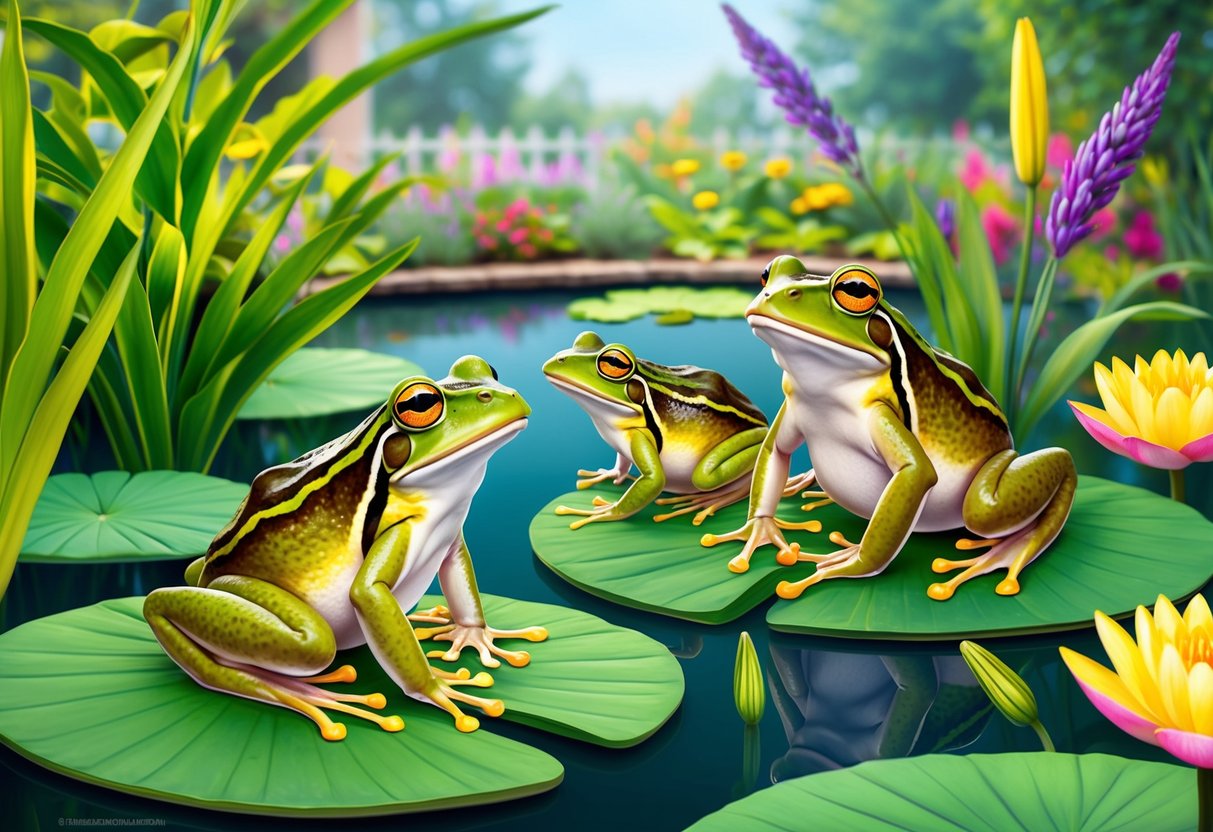
Frogs and toads bring beauty and joy to gardens. Their presence can lift moods and create a peaceful atmosphere.
Enjoyment and Stress Relief
Frogs and toads add charm to any garden. Their cute looks and funny movements make people smile. Watching them hop around can be very relaxing.
Hearing frog calls on summer nights is soothing. Many find the croaking sounds calming and great for stress relief. It’s like having nature’s own music box in the backyard.
Kids love spotting frogs and toads. It gets them excited about nature. Searching for these amphibians can be a fun family activity.
Some people enjoy adding frog decor to their gardens. Frog statues, fountains, and ornaments are popular. They add a whimsical touch to outdoor spaces.
Ecosystem Balance
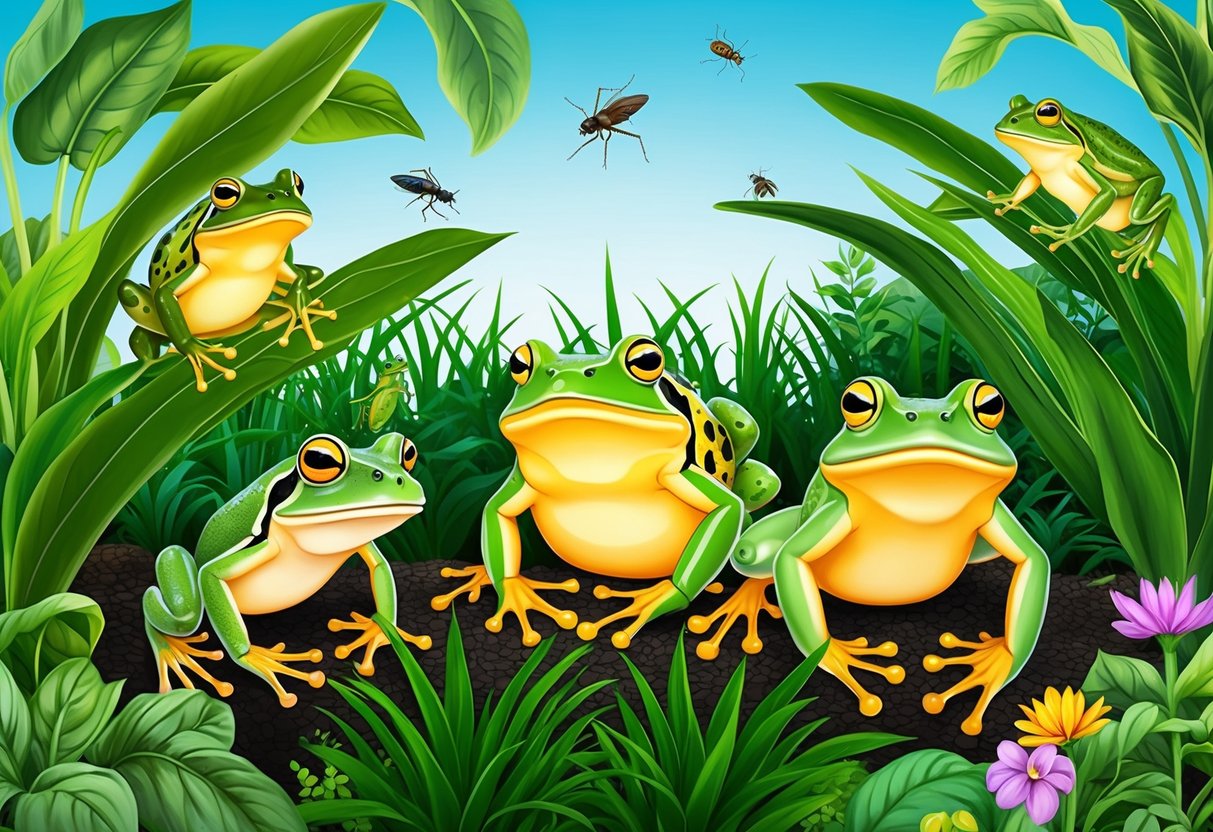
Frogs and toads play a vital role in keeping garden ecosystems in check. They help control pest populations and contribute to the overall health of your garden’s food web.
Prey and Predator Relationships
Frogs and toads are expert pest controllers. They eat lots of bugs that can harm plants, like slugs, snails, and flies. This natural pest control helps keep your garden healthy without chemicals.
These amphibians also serve as food for other animals. Birds, snakes, and small mammals eat frogs and toads. This makes them an important part of the food chain in your garden.
Frogs and toads support biodiversity in your garden. Their presence shows that your garden is healthy and has low pollution. They need clean water and plants to thrive, so a garden with frogs is often a balanced one.
To help frogs and toads, you can:
- Add a small pond or water feature
- Plant native plants for shelter
- Avoid using pesticides
These steps will make your garden more frog-friendly and help keep pests under control naturally.
Conservation and Sustainability
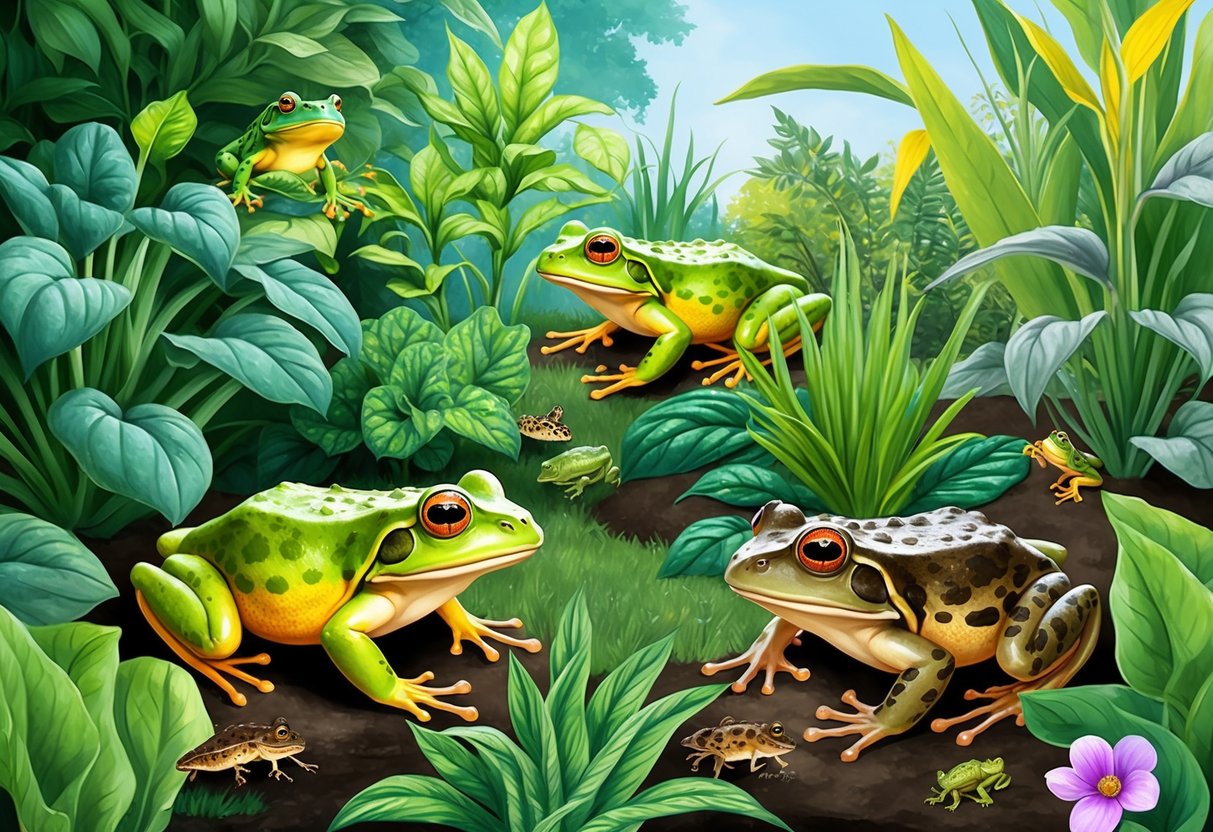
Frogs and toads play a key role in maintaining healthy ecosystems. Their presence in gardens can help protect endangered species and promote biodiversity.
Encouraging Endangered Species Protection
Gardens can be important havens for at-risk amphibians. Creating a wildlife pond provides crucial habitat for frogs and toads to breed and thrive. Even a small water feature can make a big difference.
Gardeners can take simple steps to support amphibian conservation:
• Avoid using chemicals and pesticides • Plant native vegetation around ponds • Provide shelter like logs or rock piles • Leave some areas of the garden wild
These actions help create frog-friendly spaces that endangered species can use. By welcoming frogs and toads, gardeners become part of wider conservation efforts.
Amphibians act as environmental indicators. Their presence shows the garden ecosystem is healthy. This benefits many other species too, increasing overall biodiversity.
Frequently Asked Questions
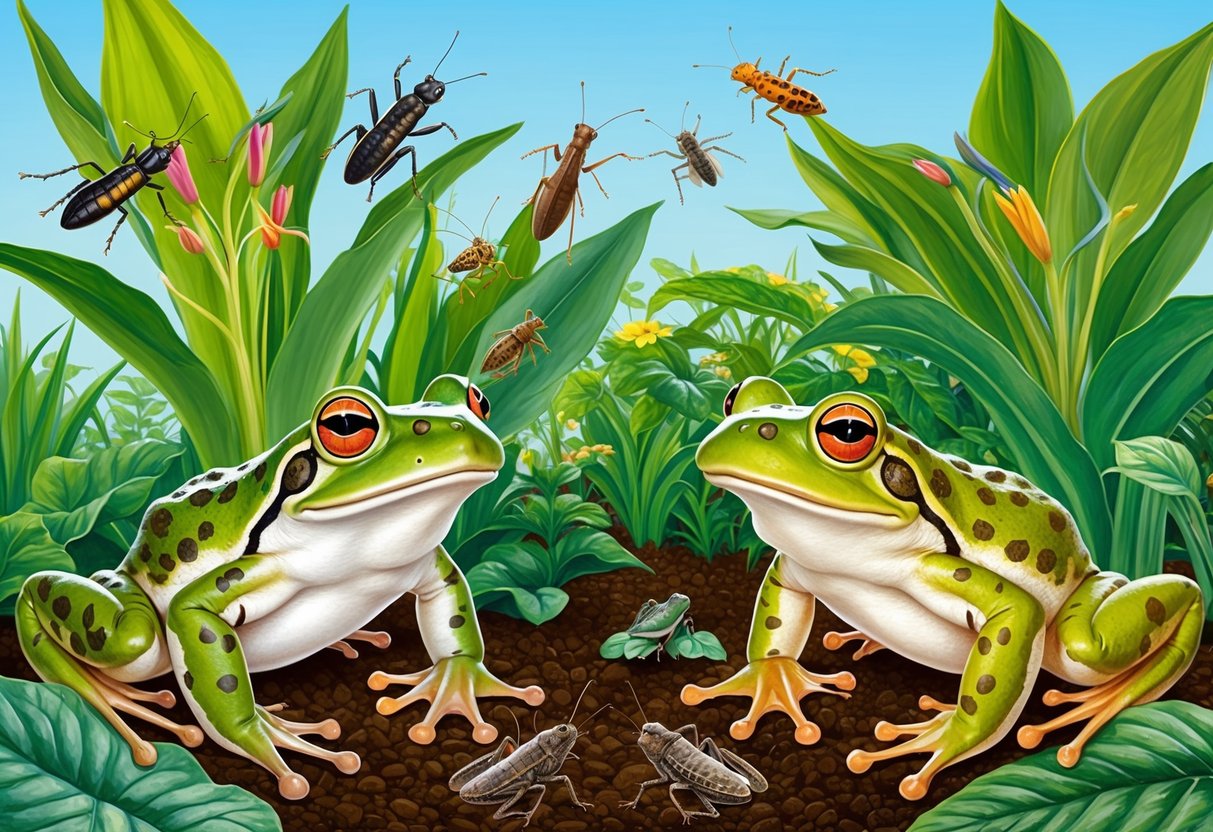
Frogs and toads can be helpful garden guests. Many people want to know how to attract them and what benefits they bring. Here are some common questions about these amphibians in gardens.
How can I attract frogs and toads to my garden if I don’t have a pond?
You don’t need a big pond to welcome frogs and toads. Small water features can work well. Try placing shallow dishes of water in shady spots.
Change the water weekly to keep it fresh. Add some rocks or plants near the water to create hiding spots.
What are the benefits of having toads in my garden?
Toads are great for pest control. They eat many bugs that can harm plants. This means fewer pests without using chemicals.
Toads also help make soil healthier. Their droppings add nutrients to the ground.
Why are frogs appearing in my garden, and is it a good sign?
Frogs in your garden are often a good sign. It means your space is healthy enough for them to live there.
Frogs are sensitive to their environment. If they’re in your garden, it likely has clean water and good plants.
Are garden toads harmful to pets or humans?
Garden toads are not harmful to pets or humans. They don’t attack and aren’t poisonous to touch.
It’s best not to handle them, though. Chemicals on human skin can hurt toads. If you must move one, wear gloves.
I found a frog in my garden; what should I do with it?
It’s best to leave frogs alone if you find them in your garden. They chose your space because it meets their needs.
If you must move a frog, use gloves. Place it in a nearby shady, damp spot with cover.
How do frogs and toads contribute to the ecological balance of a garden?
Frogs and toads play key roles in garden ecosystems. They eat many insects, helping control pest populations.
They also serve as food for birds and other animals. This creates a balanced food web in your garden.
